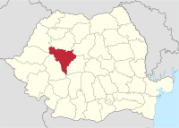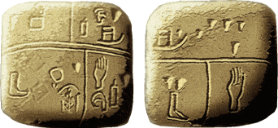Three tablets (5300 BCE)
In 1961, the unexpected discovery of these three tablets at the Neolithic site of Tărtăria (Alba Iulia region, Romania) created a considerable amount of excitement, and subsequently gave rise to a huge controversy. Their discoverer, the archaeologist Nicolae Vlassa, immediately noted the striking resemblance between these clay artefacts and the earliest text records found in Mesopotamia, which are clay tablets inscribed with cuneiform script, dating to the fourth millennium BCE (see below) Indeed, if you compare the Tărtărian tablets to the first cuneiform tablets, the similarities are remarkable.
Vlassa therefore interpreted the tablets as Near Eastern influence in Europe. However, radiocarbon datings have placed the Tărtărian tablets around 5300 BCE, which is two millennia earlier than the first Mesopotamian records! The fact that the Tărtărian tablets are so much older, makes a direct connection to the ancient Near Eastern material unlikely, and this idea has been generally discarded. Simultaneously with the rejection of the Mesopotamian link, the assumption that the Tărtărian tablets could represent some form of (proto-) writing was also dismissed, and they seldom play a role in debates about the origins of writing.



